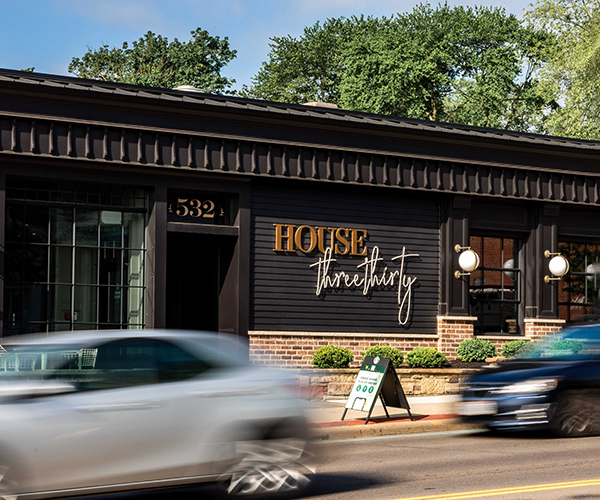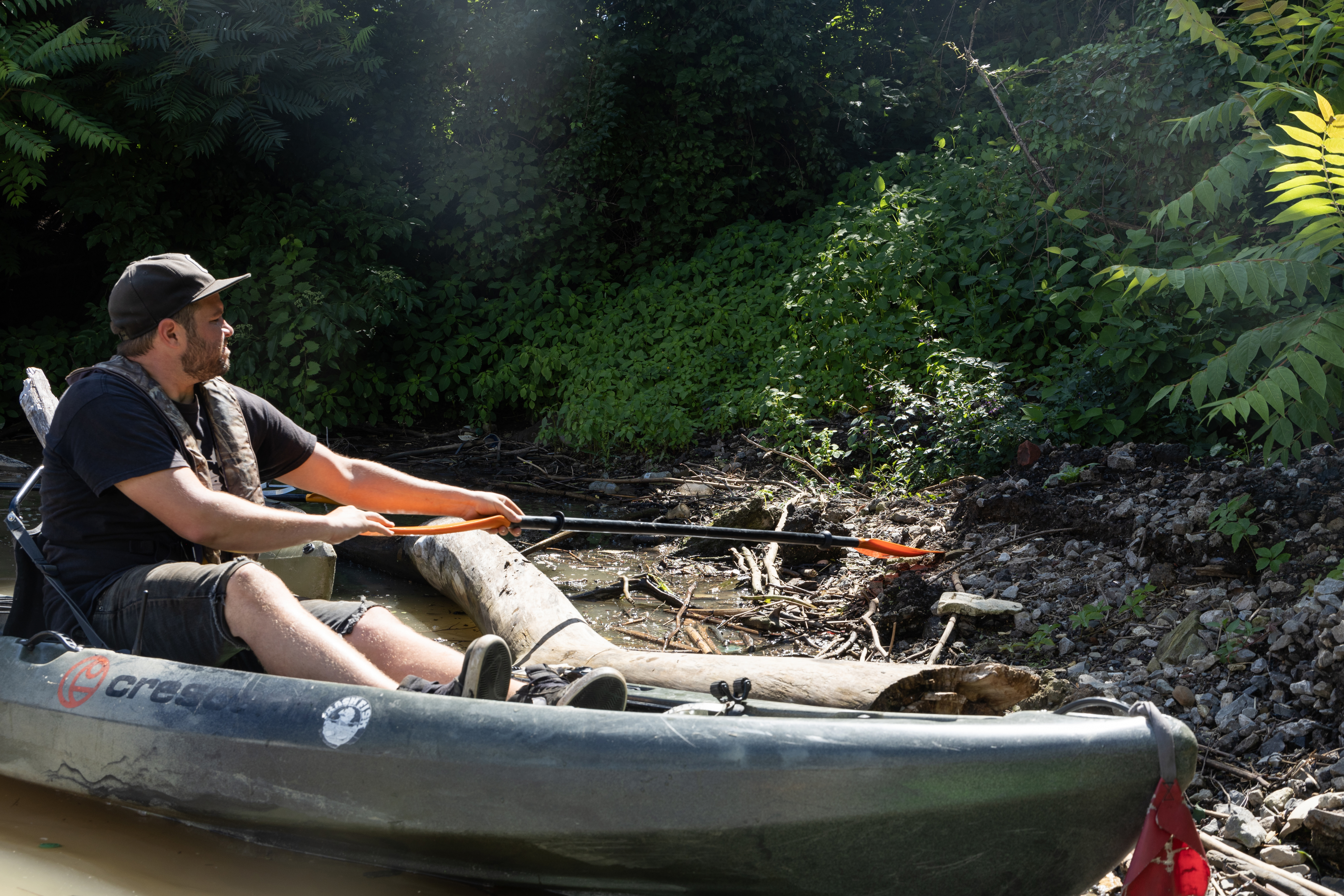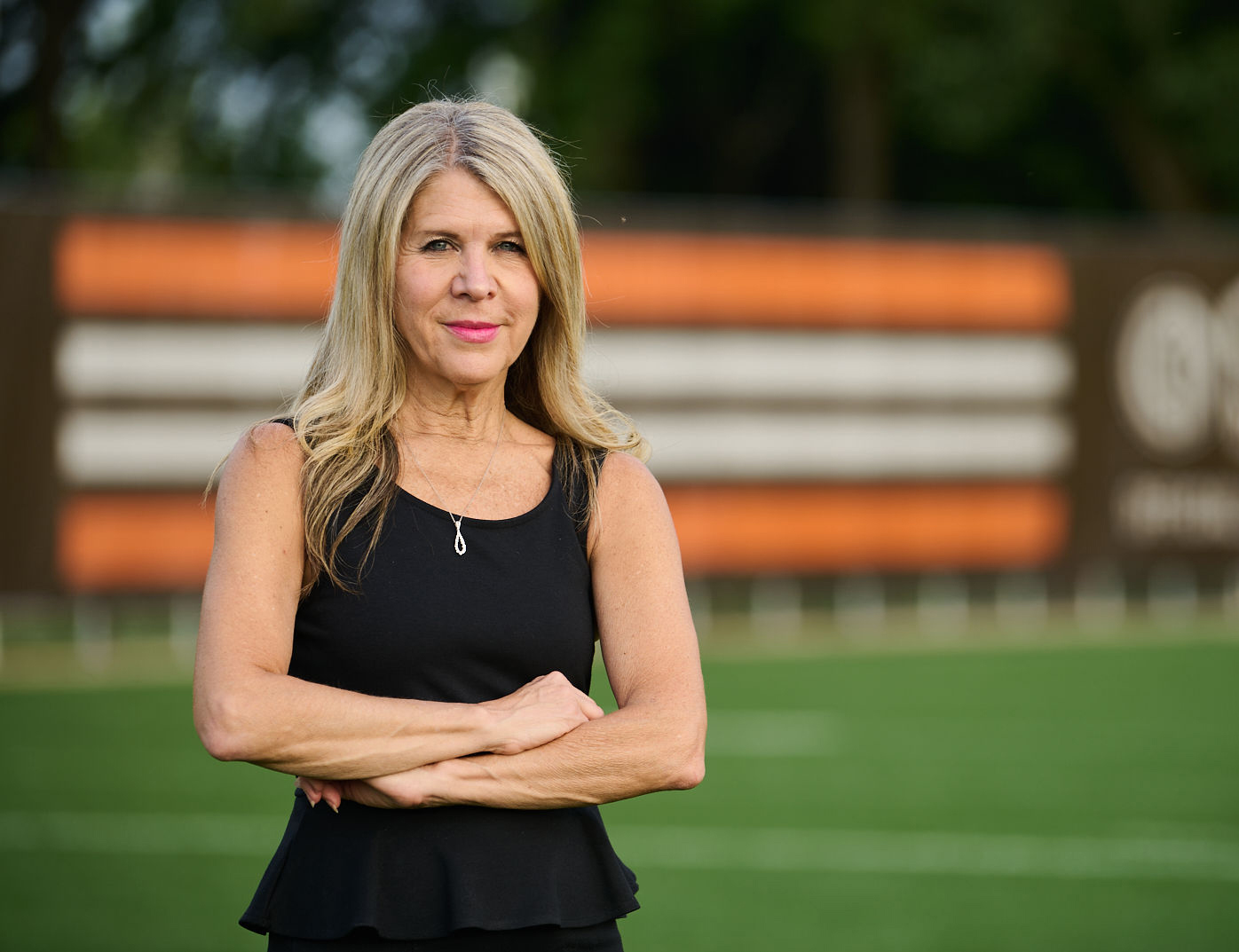The Nightmare in East Palestine
by Annie Nickoloff | Jun. 22, 2023 | 11:00 AM
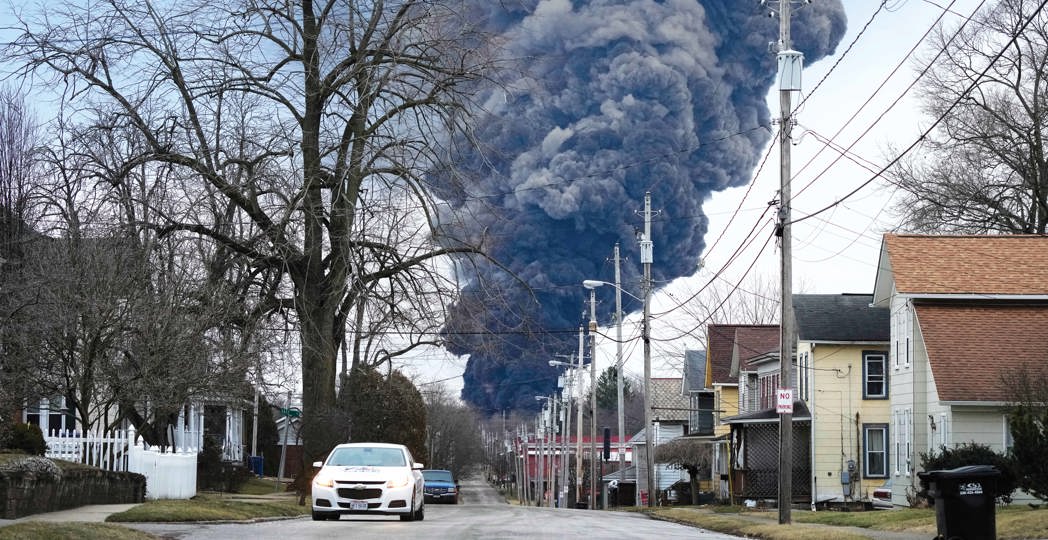
PHOTOGRAPHED BY AP PHOTO/GENE J. PUSKAR
The most eastern part of Northeast Ohio is filled with hills hugging the edge of Appalachia, where a tight-knit cluster of towns rises out of the valleys around rivers and creeks and train lines.
Towns whose names come from other places. East Liverpool. New Waterford. East Springfield, New Springfield. Different towns with their own identities but similar scenery: corn fields, country roads, farm stands, sun-dappled trees. Rusty yellow play sets, standing dewy in the sprawling city park.
A rural calm.
And before crossing into Pennsylvania, there’s East Palestine: the village of 4,700 people, the village pronounced “Palest-een,” the village of the Bulldogs sports teams, the village with a welcome sign that touts the parks, schools, churches, businesses and library, and states it is “the place to be.”
It’s the home of taverns and candle stores; of farmers and teachers; of store managers and railroad workers; of families and children. A slice of ordinary and special small-town America.
One weekend in February, this piece of Ohio became the grounds of an ecological disaster that dominated conversations around the world, injecting media coverage and political discourse into the everyday lives of its residents. It was a disaster that left East Palestine’s future in limbo.
In February, the energy in this town — like the string of derailed train cars carrying chemicals on the tracks that slice East Palestine in half — caught fire.
The Fire
Less than 300 feet away from the Ohio-Pennsylvania border sits the State Line Tavern, a low-key biker bar with a pool league and weekly wing and taco specials. The squat, blue building is neighbored by a matching blue house with an American flag strung to its garage door.
Open from roughly 10 a.m. until 2 a.m., 365 days a year, including on holidays like Christmas and Thanksgiving, naturally, the State Line Tavern is open on the first Friday of February. Kelly Berresford, who works nights, slings drinks behind the bar, while her husband Terry Berresford winds down, wrapping up his day shift. It’s the one part of the day where the couple’s hours overlap.
Regulars order beers and rack pool balls at two green-felted tables, chatting with Kelly, celebrating the end of the work week. The old-school stained glass light fixtures glint off the games below.
It’s an average Friday night until it isn’t. Around 9 p.m., Kelly hears the familiar screech of a train’s brakes — but louder. Much louder.

It interrupts the normal hum of the State Line Tavern, and the steady background noise of East Palestine’s stream of freights.
In the moment, Kelly doesn’t think much of it. She keeps working.
Minutes later, a customer slams open the metal door.
“It’s all on fire,” he shouts.
Outside, a line of flames paints the sky into an orange horizon, just down the tracks that cut through the bar’s backyard. Moments later, sirens wail. Police arrive, ordering everyone to evacuate the area. Meanwhile loyal customers plead with Kelly: “Can I have just one more beer?”
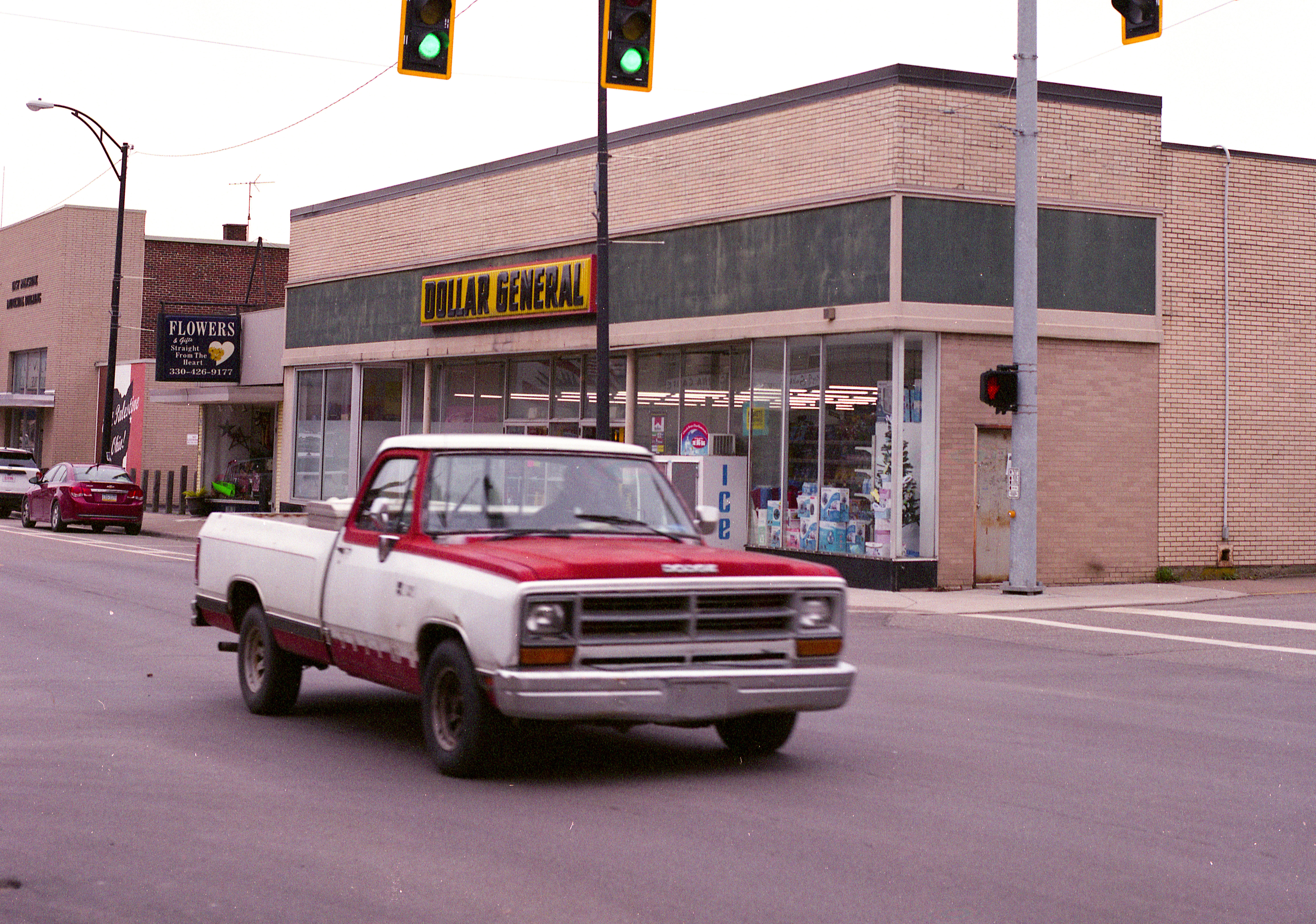
In the night, as bar-goers pull out of the gravel parking lot, a stream of firetrucks blares in from 50 Ohio and Pennsylvania departments, squealing down the two-lane road and toward the blaze.
Just one block down the street, somehow avoiding Leake Oil Co. and other structures, 38 train cars had slipped off the tracks, now in a tangled mess in a stand of trees and brush. A thick black smoke billows into the night sky, out of the wreckage, visible in the light of the fire that sparks in some of the cars.
Soon, that smoke creeps into the glow of the village’s streetlights.
Around that time, in a different part of town, Misti Allison gets her two kids to bed — what she calls “the bedtime hustle” — after spending the evening at her second-grade son’s basketball practice. Her family group text lights up with a message from her sister-in-law about a train accident nearby.
“Sometimes they happen, train wrecks,” Allison says, “but it’s typically a train hitting a car that goes through the crossing.”
Allison and her family soon hear sirens, from somewhere beyond their residential neighborhood tucked between East Palestine High School and a patch of woods. While she settles her 1-year-old daughter in for the night, her husband, Aaron, steps down their home’s long winding driveway — and witnesses a glowing fireball in the distance.
He rushes back inside, and the couple watches for news updates that night.
Then, like their kids, they go to sleep.
“In hindsight, if we would have known what was on that train, we would have woken our kids up and left town that night,” Allison says, “but we had no idea.”
In another corner of town, Katie Beight wakes up from a couch nap, groggy, to a friend’s phone call urging her to look outside her window at the smoke. “Shut up and leave me alone,” she responds grumpily.
But her friend persists. Something is off. Beight shuffles to her window, trying to shake off the sleepiness at the end of the work week.
Then, she's instantly awake. Flames and smoke mix in the night air — and it’s not long before a police cruiser drives down the street, its loudspeaker crackling.
“Please evacuate the area.”
Beight stands, frozen, for a few moments before gathering her family and her two cats. With her neighbor, she darts to another house in town, further away from the blaze.
A smell, and a feeling, blankets the village of East Palestine that night. The smell: something chemical, between melting wires and melting plastic, says Beight.
The feeling: chaos.
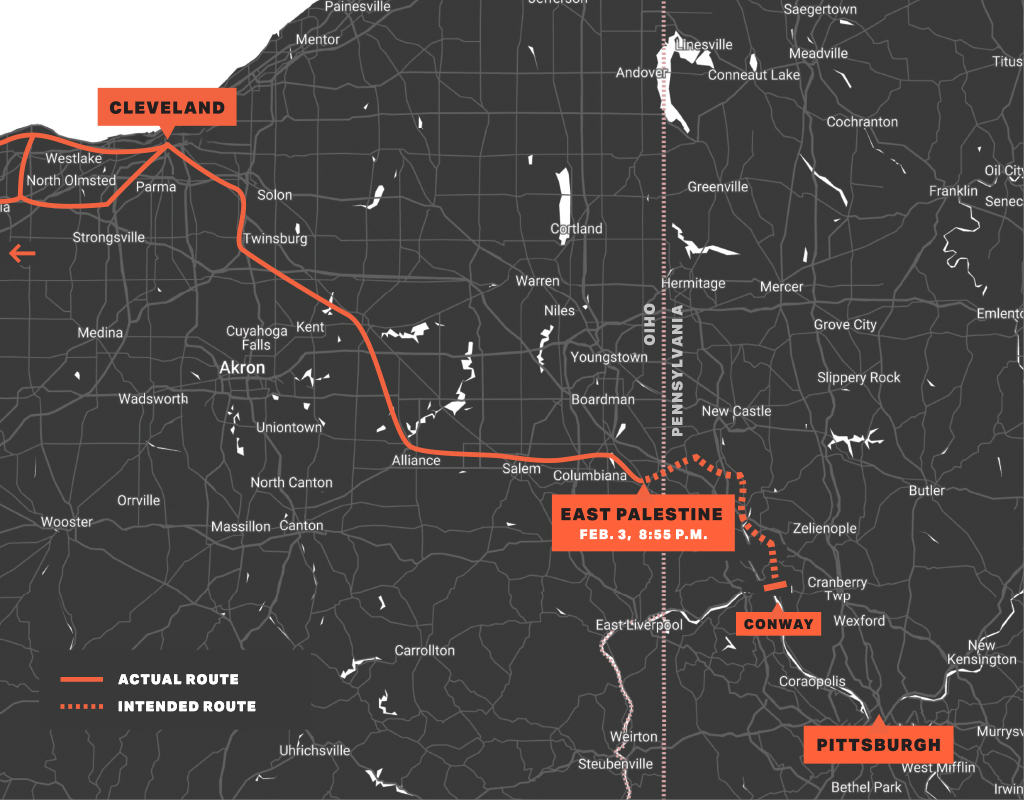
The Evacuation
Before police cruiser lights flash into windows and before authorities rap on front doors that weekend, locals learn of the event in a telephone game of calls and text messages. A train derailed. Get away.
On Friday night, Sidney Smith sits with family at her parents' house with her brother, who’s home from Chicago for the weekend. Her cousin, also in town, calls. “Look out your window.”
Smith and her family peer out of the doorway at a strange, threatening glow just a quarter-mile away from the home, creating a doomy silhouette of the barn and silos on their property. “Holy cow,” Smith says.
Worried that the fire could consume the backyard’s woods, the family treks to the top of a nearby hill: a vantage point to see through the trees. There, they see an inferno along the train tracks in the distance.
“I called my fiance, and I was like, ‘Hey, you might want to get out of the house,’” Smith recalls.
Smith’s fiance hurries out of downtown, from the apartment the two share above 1820 Candle Co., where Smith works with her mother. A drive that typically takes five minutes lengthens into a 35-minute snarl.
“By the time he got to my parent’s house, that was when the troopers and sheriffs pulled up, and they were like, ‘Hey, you guys have got to go,’” Sidney says. “Then we packed everything up and left.”
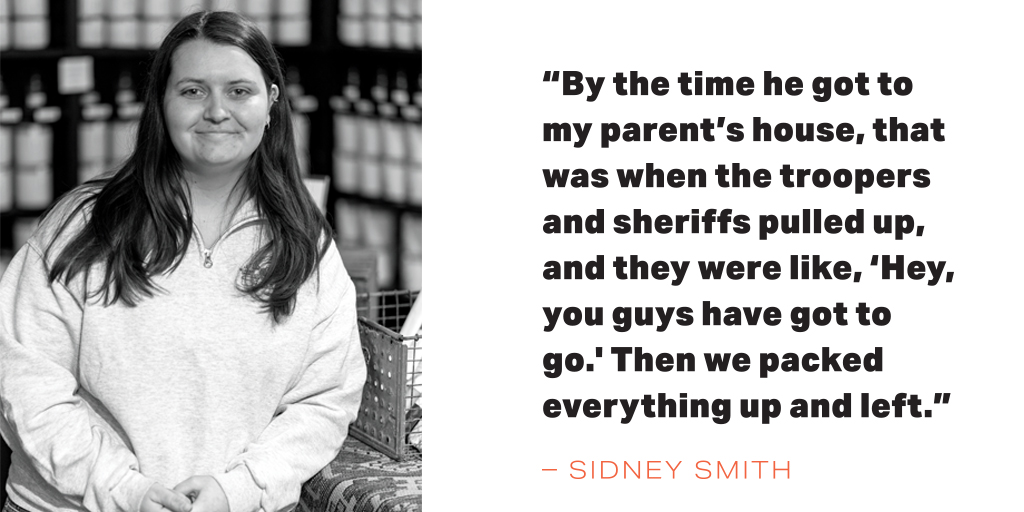
Meanwhile, for Melissa “Moo” Blake, the derailment interrupts her first day in a new home.
“I’ve been homeless for a while. I was sleeping on peoples’ couches. I was sleeping out of my truck,” Blake says. “Community Action got me my own apartment the day before all this — that Thursday.”
On Friday, Blake scrubs the apartment (located a bit more than a mile away from the derailment) and starts to settle in, when she gets word about the train. The apartment manager tells her and fellow residents that they can stay that weekend, or leave — “as long as we’re off the street,” she says — and Blake remains in her new space on Friday and Saturday.
While there, Blake smells the smoke, carrying a chemical scent into her apartment — one that stands apart from her cleaning supplies. She develops a cough that later brings her to Salem Hospital and, she says, a diagnosis of acute bronchitis.
The fumes flow over the weekend. Firefighters discover flammable carcinogens on board several tank cars and decide to let the contents burn out, evacuating a one-mile radius around the scene.
Videos of residents and various angles of the fire, visible from backyards and driveways, surface on TikTok and Twitter. Residents share photos of blankets draped over windows, doors taped shut, comments about the smell — some say it’s slightly sweet; some note the nose-punch of formaldehyde and chlorine.
Social media, as it so often does, becomes the messy grounds of information-gathering and check-ins and early-stage storytelling.
Here, the train itself comes into focus: a Norfolk Southern freight, just one of thousands of locomotives that traverse the company’s extensive web of tracks. Since 2018, the company has experienced about 250 accidents per year, according to federal data.
In East Palestine, the train cars, scattered like toppled dominoes on a weedy field, smolder over the weekend. Another tick in the 2023 accident tally.
By Sunday morning, the flames mostly burn out, flaring through tank cars of chemicals like polyvinyl, polyethylene and butyl acrylates and, also, a hopper of semolina grains and a boxcar of frozen vegetables.
This is, it turns out, just the beginning.
Several tank cars contain 115,580 gallons — about six backyard swimming pools’ worth — of vinyl chloride, a toxic chemical used to create plastics for PVC pipes and car upholstery. And in one of those cars, a malfunctioning relief valve.
Over the weekend, while other cars smolder and extinguish, the temperature in one rises.
Here’s what happens when vinyl chloride is exposed to heat: an exothermic, rapid polymerization reaction. It gets really hot, really quickly. A potential for explosion.
A metal train car, pressure building, building, building until it might burst.
Oh, and in this situation, it is also surrounded by thousands of gallons of other flammable chemicals, lurking in damaged cars and leaked puddles.
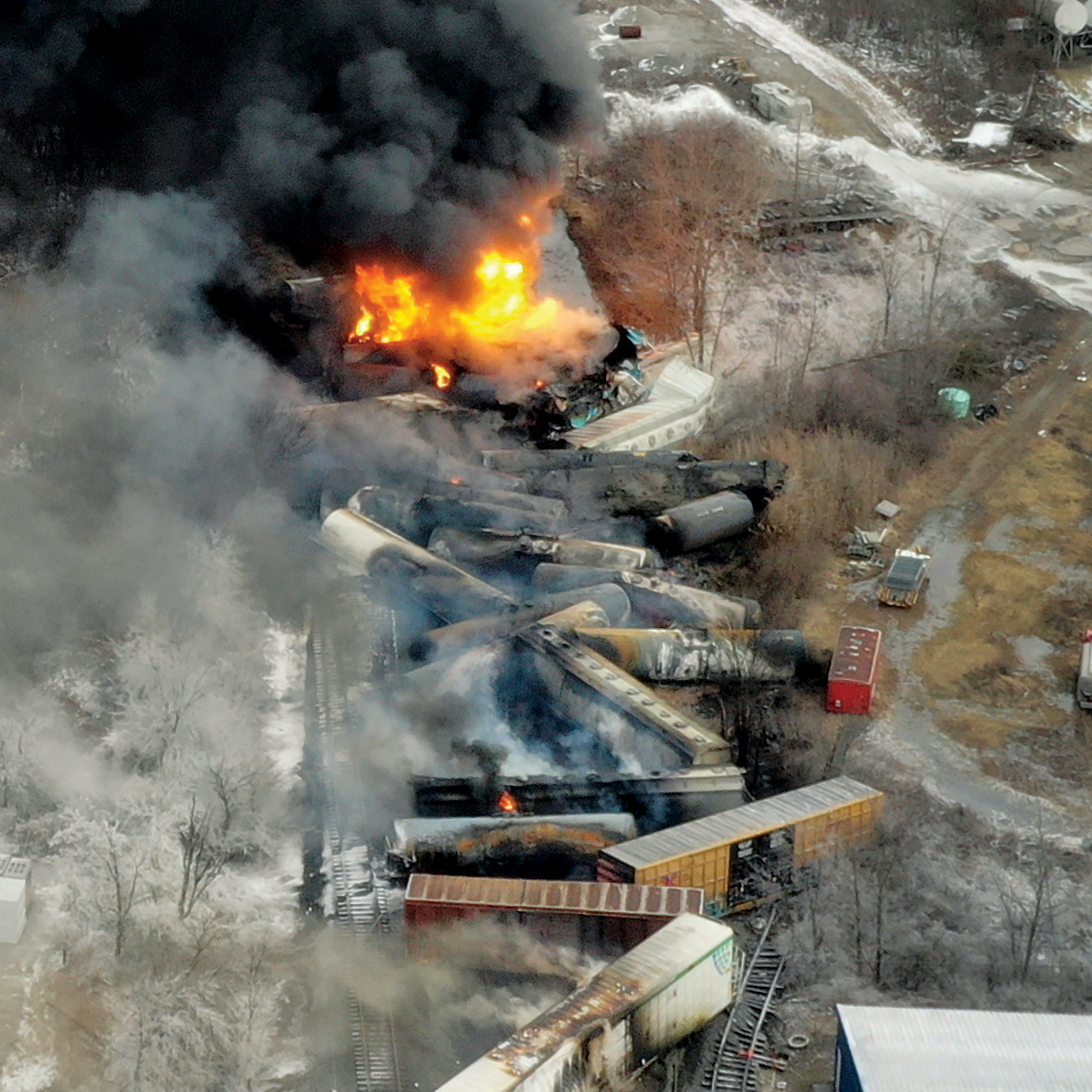
And beyond all of that, a small village.
More evacuations. First-responders knock door-to-door. Ohio Gov. Mike DeWine activates the National Guard on Sunday night to assist with the response.
“They were telling us that we either had to leave, or they’re coming back with body bags; that was the sheriff, knocking on our doors Sunday, for the controlled release,” Blake remembers. “Everyone met down at the playground at the park.”
Many of the village’s 4,600 residents leave, staying in hotels or with family and friends nearby, or not-so-nearby. Some choose to stay; others can’t go. The American Red Cross opens an evacuation center inside the high school gymnasium on Saturday morning and hosts more than 100 overnight stays that weekend.
Not too far away, the heat ticks up and up in the train car.
People in the small cluster of towns look to state leaders — DeWine and Pennsylvania Gov. Josh Shapiro — for action. As the pressure builds, they consider two primary paths.
“One option was to do nothing and wait for the car to explode … which would result in shrapnel going out, close to a mile,” DeWine says in a Feb. 14 news conference recapping the incident. “We also looked at what the danger was from a controlled release, which is what the railroad felt should be done.”
Together, the two governors decide on the controlled release suggested by Norfolk Southern. They alert nearby residents.
On Monday, Feb. 6, at around 4:15 p.m., the release begins with shaped charges: explosives, punched into the rail car walls, allowing its contents to spill out into a trench, some seeping into the soil. And this chemical — which “can be deadly if inhaled,” according to a DeWine release — is then ignited.
A plume of dark-gray smoke rises into the sky.
The Release
Further from East Palestine, some neighboring residents aren’t as tuned in to the controlled release until it occurs. In Chippewa, Pennsylvania, Tyler Bevington hadn’t worried much about the weekend’s events until his daughter is sent home early from Blackhawk schools on Monday afternoon.
Bevington's daughter gets off the bus sniffling.
"She didn’t know what was going on. I don’t know exactly what they told them, but she came home crying because she knows I run around and work a lot,” Bevington says. “She didn’t know if I was home, or what; if [the release] had actually went off, or what.”
Bevington, his family and a friend all load into the car and drive away from their home, located about 10 miles away from the derailment, and head 30 miles away to Robinson, a Pittsburgh suburb.
Once there, their eyes fix on their phones, watching for updates about the weekend’s events on local news and social media. After dinner, Bevington goes back home to take care of his dog and cat — driving straight into a wall of smoke from the controlled release.
“It was night and day, literally,” Bevington says.
That night, Bevington feels a cough in his throat.
“I was trying not to be a hypochondriac,” Bevington says. “I felt stuff in my chest, a very itchy, irritated feeling in my chest. It’s just a scary thought.”

Moving closer — roughly five miles away from the derailment site, near the border between Columbiana and East Palestine — Emily Wright and her family hunker down on Monday afternoon, waiting for the controlled release. Living in a multigenerational household with both her grandmother and her father, who has a disability, Wright says she didn’t have time to arrange for her family to get out of town.
After picking her daughter up from school, Wright and her family change their home’s air filter, tightly lock all their windows and wait. And wait.
The dog scratches at the door, pleading to go outside. Wright eyes the sky through her white-rimmed glasses and checks her watch, as minutes tick by the scheduled controlled release time of 3:30 p.m. She lets her dog out, and takes care of other things around the house. She brings the dog back in.
It’s not until around 6 p.m., when she starts feeling a little wheezy, that she realizes something is amiss.
Then, Wright looks out her home’s north-facing window. “It was night, but not night, and you couldn’t see the normal lights over in Youngstown,” she says.
Closer, still, to East Palestine, Danielle and Geoff Miller catch whiffs of chlorine in their Enon Valley, Pennsylvania, home on Saturday and Sunday. It causes a burning sensation in Danielle's throat, nose and eyes — so intense, that she wears a face mask at all times to ease her symptoms.
On Monday, Geoff heads to work in Cranberry, Pennsylvania, about 20 miles away. Then, the home is eerily quiet. Even the birds are quiet, Danielle remembers.
All day, she listens intently, expecting to hear the boom of an explosion during the controlled release.
Instead, early that evening, she hears a series of pops. She slides open her back door, steps outside and gapes: A black column of smoke rises high into the sky over neighbors’ farms and forests on the hillside.
It grows larger. Closer.
“When I saw the plume, looking almost like an atom bomb, if you will, and then I saw the cloud of that, coming closer and closer to our house, and then it was over our house, it was one of the scariest feelings I’ve ever felt,” Danielle says. “And then I started to smell it. I immediately put my cat in her kennel and stuck her in the car and started driving.”
Danielle, like many of the residents of this small cluster of small towns, leaves her home and, for the next few days, desperately seeks information.

Details trickle slowly out of DeWine’s office, slowly out of Norfolk Southern’s office, letters and notes from President and CEO Alan Shaw.
Slowly, out of the Ohio Department of Health, the Ohio Department of Natural Resources, department of whatever.
Out of sprawling Twitter threads and community Facebook pages.
Out of TikTok videos of dead fish, slowly drifting in East Palestine’s streams.
Out of Instagram Reels showing the same train moving, on fire, in Salem, Ohio, 20 miles before the derailment.
Details, details slowly come to light, of what, exactly, happened in East Palestine on that February weekend.
Meanwhile, Norfolk Southern quietly repairs the rail line next to the cleanup site. Within one week, trains begin to rumble through East Palestine once again. The freights slow as they pass the scorched, crumpled metal husks and polluted dirt.
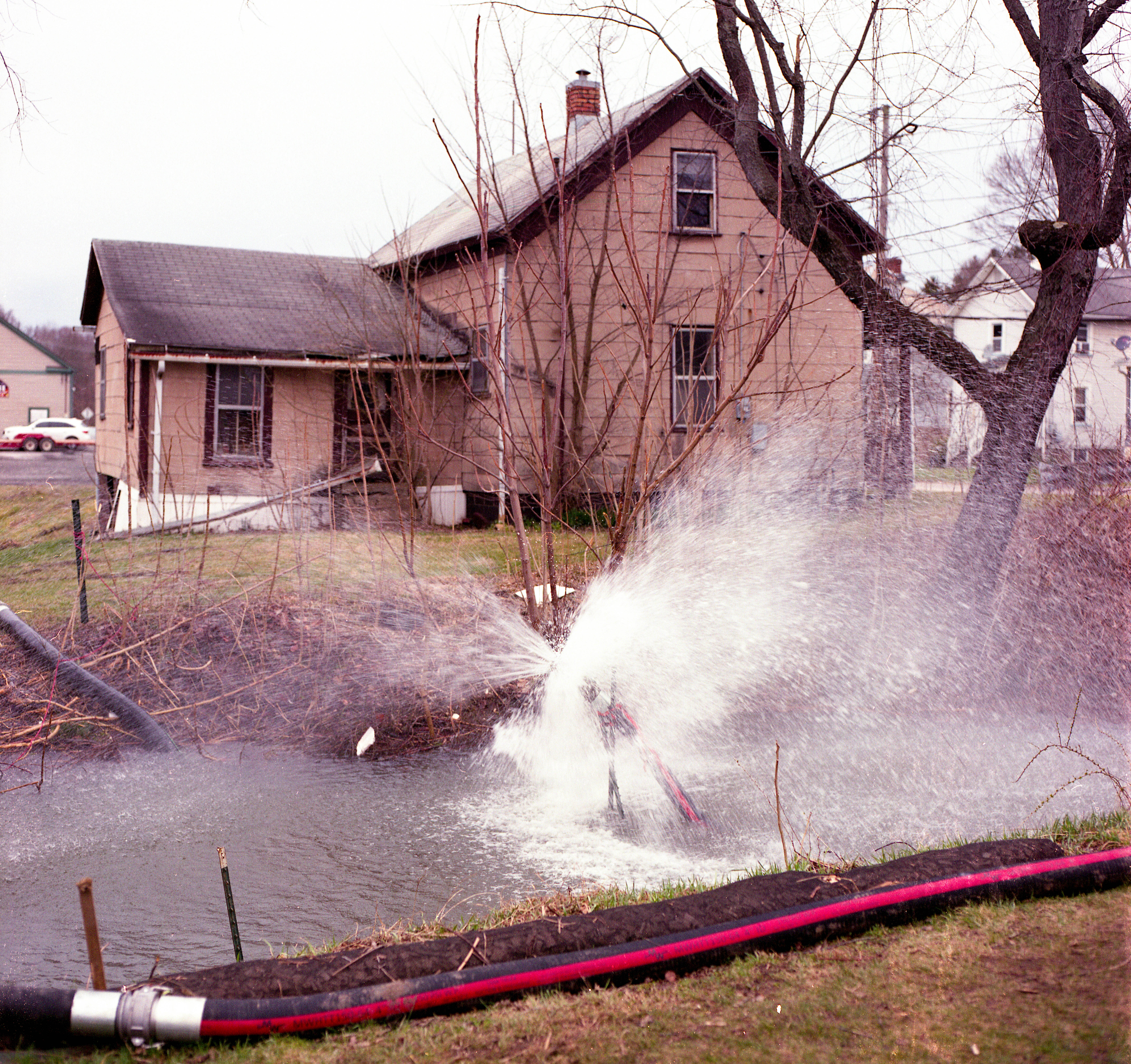
The Meeting
On Feb. 15, nine days after the derailment, the sun sets behind the sprawling high school grounds while a line forms outside the gymnasium. Families and friends huddle in conversation, broken only by the bright lights of TV cameras and microphones.
“I need to get away from them,” one woman says, scowling and hobbling away from an inquiring TV news reporter, moving closer to the glass doors.
On this unseasonably warm winter day, hundreds of locals gather to find answers to their questions. Mothers carry fussy toddlers; adults wheel their elderly parents along the walkway; nonprofit agencies hand out pamphlets, down the line, one after another, as the dusk shifts to darkness.
Inside the lobby are rows of snacks, water, coloring books, disinfectant wipes and laundry detergent for folks to take home. Signs share the names of agencies and organizations present — with Norfolk Southern’s name scribbled out in pen.
On the wall above the visitor’s side, a big mural of an angry-looking, sharp-toothed bulldog snarls above a set of bleachers that quickly fills with people. The room is tense, full of chatter and questions and, yes, some answers, but none from Norfolk Southern.
The railroad announced just hours before that it would not be in attendance due to threats against workers.
“Railroad’s not here,” snorts one woman, chatting with her church group against a side wall of the gymnasium. “We weren’t important enough for that.”
Mayor Trent Conaway, in his bright blue polo shirt and blue jeans, handles the role of emcee, carrying the microphone to speakers. Amplified voices bounce around the gymnasium, echoing off the brick and bleachers as the crowd quiets and roars, breaking into applause following residents’ comments about media coverage and property values and health — always returning to health.
A child, no more than 10 or 11 years old, asks about the smell. A man says he breathed the smoke the night of the train crash and thought he was going to die. A row of densely packed television cameras line one end of the gymnasium, lenses focusing to capture the sights and sounds that make up news reports widely circulated the following day.
Crinkled hand-painted posters impose cheering phrases like “Learn To Take The HEAT, You’re About To Get BEAT” and “DAWGS GOTTA EAT” above the filled stands, as residents repeat the biggest question about symptoms anecdotally experienced by many East Palestine residents — and their concerns for future health developments from their exposure to the toxins released into their village. Asthma. Autoimmune conditions. Cancer.
Promises, promises, promises from the railroad company that didn’t show up. The scientists and doctors, who look small on the floor in front of this mass of people, explain their careful measurements and studies and details around volatile organic compounds and the dynamics of odor thresholds. They traverse the delicate, contaminated ground of East Palestine. Somewhere underneath another student-made poster reading “Be LOUD Or Go Sit With UR MOM,” another man’s voice interrupts, repeats the same booming question no one can quite completely figure out.
“WHY ARE PEOPLE GETTING SICK?”
And the “why” of it is given some mix of answers and non-answers, as the people — the hundreds of residents — an hour later leave the gymnasium with a collective sigh and go home.
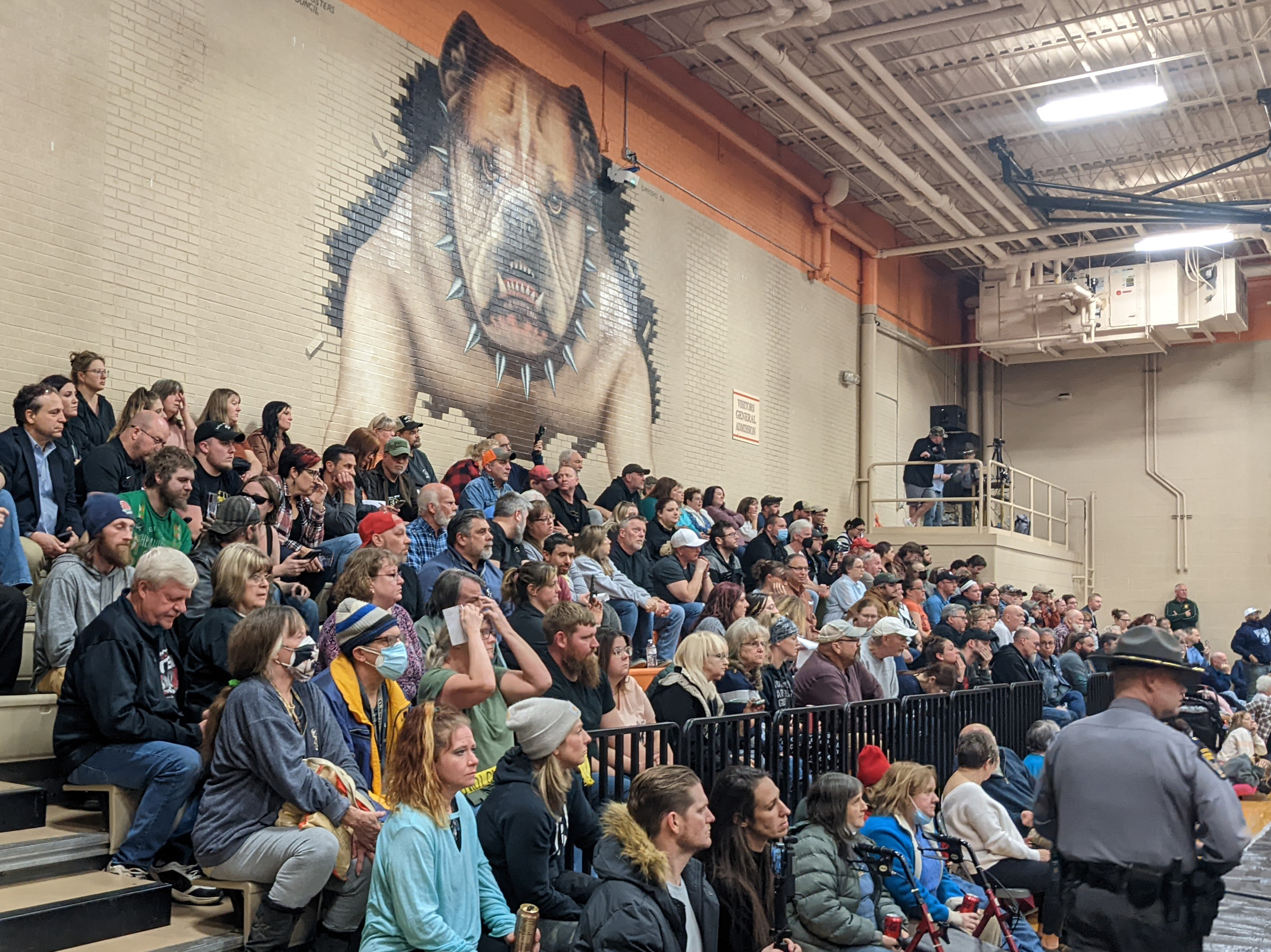
The Parade
In the weeks following the train derailment, more and more town halls and meetings fill spaces in East Palestine. News crews film remediation efforts in small creeks; they interview residents in front lawns and lug camera equipment as close to the derailment site as possible, often ignored by Norfolk Southern employees in orange vests. Cameras zoom in on minnows, bobbing belly-up in the water.
Ordinary people show up, hoping to help. A “Jeep invasion” brings hundreds of Jeep enthusiasts into the village to support local businesses. Fundraisers and benefits pop up all over Northeast Ohio, donating proceeds to those affected. Some Ohioans, like Rob McFadden, who drove in from Canton on the night of the Feb. 15 town hall meeting, also hope to do a little good. McFadden loaded up his van with 60 cases of bottled water, and handed them out to anyone who walked by.
“It’s not left versus right. It’s haves versus have-nots,” says McFadden, who grew up as a self-professed “punk kid.” Later, referring to Norfolk Southern, he’s more pointed: “Corporations are f------ cowards.”
After missing the town hall event, Norfolk Southern's Alan Shaw makes his way to East Palestine in the next few weeks, eventually meeting in focus groups with local leaders and residents to address concerns and ensure cleanup efforts.
The Environmental Protection Agency gets involved early on, ordering Norfolk Southern to cover the city’s cleanup costs. Teams dig trenches, unearth soil and pile it into large blue canisters. Air testing stations pop up around town, wired to telephone poles near intersections and standing on spindly tripods, probing the air for harm.
Weeks after the derailment, data from the Ohio Department of Natural Resources reveals that carcinogens in local streams killed an estimated 38,222 minnows and 5,500 other aquatic creatures. Necropsies for a variety of other deceased animals (one calf, three birds, one opossum, four raccoons, one muskrat and one snapping turtle) do not determine chemical toxicity as the cause of death.
Anecdotally, nearby residents share photos and stories of sick and dead foxes, chickens, dogs and cats on social media.
A preliminary National Transportation Safety Board investigation determines the likely cause of the derailment: a faulty wheel bearing, which overheated and failed. The train, on its way from Madison, Illinois, to Conway, Pennsylvania, had passed through Cleveland earlier in the day, before it derailed about 22 miles away from its destination.
Working conditions for Norfolk Southern employees surface; the derailment occurred not all that long after a 2022 labor dispute between freight companies and their workers, where unions pushed back against strict attendance and on-call policies, a lack of sick days and low pay.
The ongoing conversation hones in on a system used by most freight trains today called “precision scheduled railroading.” The model, introduced in the ‘90s, emphasizes long trains and simplified routes. In recent years, freight trains have sometimes reached hulking, miles-long sizes that can cause safety and mechanical issues.
In 2019, Norfolk Southern rolled out its own precision scheduled railroading plan, which would make its operations more efficient and “drive long-term shareholder value.”
One month after the East Palestine derailment, 28 Norfolk Southern train cars derail in Springfield, Ohio, on March 4. They slide diagonally down the tracks, cramming and crumpling.
“NO hazmat involved. NO injuries reported,” tweets Norfolk Southern spokesman Connor Spielmaker. “There is NO risk to the public.”
Soon, East Palestine welcomes politicians. Sens. Sherrod Brown and J.D. Vance; Transportation Secretary Pete Buttigieg; former President Donald Trump, who disperses pallets of Trump-branded bottled water.
Activist and paralegal Erin Brockovich takes particular interest in the village, visiting multiple times, hosting a massive town hall where she and a team of lawyers including trial attorney Mikal Watts present a case for litigation against Norfolk Southern.
Experiencing lingering symptoms like a burning throat, fatigue and headaches following the derailment, Danielle Miller, a fan of Brockovich’s past work taking on groundwater contamination cases in the ‘90s, briefly meets Brockovich following the event. They snap a smiling selfie together.
“It was such a terrible way to get to meet somebody so amazing,” Danielle remembers. “To hear Erin and her team, during that meeting, say that it really, truly, is very bad, it was almost like a relief, in a very strange way. I was like, ‘Wow, somebody’s actually being honest with us.’”
The Forward Movement
In late March, Misti Allison heads to Washington, D.C., to share her family’s story with a Senate committee. Seated in a rectangular ring of representatives and senators, she dons a red “Moms Clean Air Force” pin underneath a pearl necklace, and gives nearly four minutes of testimony.
She talks about her family’s fear of potential health and economic consequences — her 7-year-old son, who asked if he would die from living in their home. She mentions her community’s distrust with Norfolk Southern, and residents’ demands, which include healthcare monitoring, home value protection and an economic development plan for the village.
And in the midst of all of that, she shares a story about her mother, who died after a long battle with cancer just weeks after the derailment.
“My mom always told me, ‘Either you find a way, or you find an excuse,’” Allison says. “So it’s time to learn from this and move forward together. Let’s find a way. Not another excuse.”

Norfolk Southern disperses funds, initially giving $1,000 payouts to cover displaced and affected families. The company establishes a scholarship for graduating high school students and a string of forgivable loans for local businesses. It donates a historic train depot to the city and establishes a master plan to revitalize the city park.
While the air and drinking water test clean for contaminants, Norfolk Southern continues to scrub East Palestine’s surface waterways. Humming generators power air sparging in Leslie Run and Sulphur Run, where bursts of water and volatile organic compounds shoot out of the creek in flagged-off sections.
Brokovich establishes the East Palestine Justice group of attorneys to represent some residents. Other law groups do the same.
Dozens of local businesses, residents and organizations file lawsuits against Norfolk Southern, later consolidating into one. Lawsuits arrive from local school districts, including Pennsylvania’s Blackhawk schools, Ambridge Area schools and Western Beaver County schools. The Justice Department files a lawsuit stating that Norfolk Southern violated both the Clean Water Act and the Comprehensive Environmental Response, Compensation and Liability Act. A federal lawsuit from Ohio Attorney General Dave Yost aims to keep Norfolk Southern accountable in its cleanup efforts of the “entirely avoidable” incident.
Meanwhile, a bipartisan group including Ohio Sens. Brown and Vance introduces the Railway Safety Act of 2023 to the Senate on March 1. The legislation aims to improve safety standards for trains which carry hazardous materials, update inspection requirements, maintain defect detectors and ensure freight train crews consist of at least two people, among other regulations.
The “common sense” bill meets opposition.
Norfolk Southern’s Alan Shaw testifies before the Senate on March 9, glancing down with a furrowed brow to read through pages of measured notes to the room of political leaders. When asked if he would commit to supporting the Railway Safety Act, Shaw sidesteps the question, saying he’s committed to the “legislative intent” of the bill.
Saying he’s “determined to make this right” and that Norfolk Southern “will be in the community for as long as it takes” to clean up, Shaw cites the millions of dollars the company has put toward remediation and local assistance.
As of June 9, the company has spent $36.5 million on East Palestine, according to its website. The number continues to rise.
Some more numbers: In 2022, Norfolk Southern’s operating revenue reached a record $12.7 billion. That same year, Shaw made $9.8 million in total compensation — double the $4.7 million he was paid the year prior.
On the same day that Shaw testifies, news breaks of another Norfolk Southern train derailment. This time, approximately 30 cars in Calhoun County, Alabama.
Weeks later, on May 10, a Senate committee votes to advance the legislation. The bill inches forward.
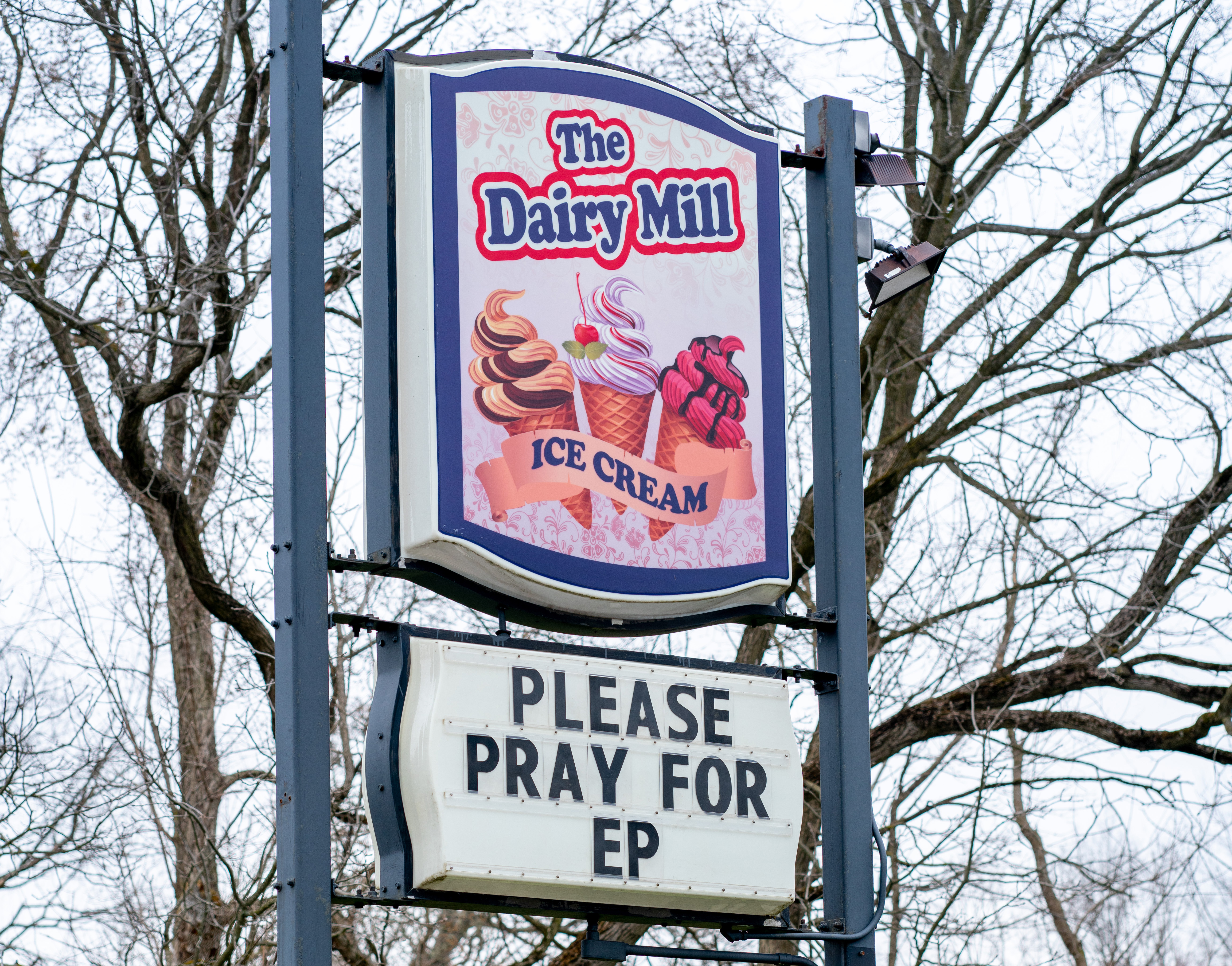
Steps forward, and steps back. In East Palestine and its surrounding communities, residents remain on edge about the event and its aftermath.
These days, Danielle Miller says she feels more alert when dozens of trains rumble by her Enon Valley home. Miller, who grew up in nearby Darlington, used to enjoy the sound — the familiar rumble of home.
“It was just part of your daily life. Now I am noticing every train, and I’m like, ‘Oh my gosh, I did not know we had this many trains,’” Miller says. “It’s almost like you just stop and brace yourself. And I don’t like the sound of trains anymore at all.”
Wright, through her former work with River Valley Organizing, a nonprofit based in the Appalachian Ohio River Valley, signed hundreds of residents up for independent soil and water testing. RVO has also worked to establish long-term studies through local universities, while supporting federal policy changes.
Back at the State Line Tavern, Terry and Kelly Berresford wait, unable to reopen their business while cleanup efforts remain underway on East Taggart Street.
Most days, a security guard waves these familiar faces through the locked-down street and most days, the Berresfords straighten things up at the bar. After they’ve been there for an hour or so, Kelly says she experiences headaches and a tingling sensation, and Terry, a tightness in his chest and coughing.
So they don’t stay for too long. Sometimes, when they head home, they bring some of the beer, inching closer to its expiration date, with them — ready to host another party on their porch.
In May, they traveled to Europe, celebrating five years of marriage and 30 years together. (“We work morning, noon and night,” Kelly says, wearing her dirty-blond hair in a signature high part-ponytail. “It was fun, and we didn’t have time to take out for a wedding.”)
Now, they have plenty of time on their hands. Every day, they come in from their home in a nearby Pennsylvania suburb, unlock the doors, check the coolers and make sure things are in working order.
When they get closer to knowing when they’ll reopen, the couple plans on bringing in a professional cleaning company to make sure the bar is disinfected and cleared of any potential contamination.
“I don’t want to get that soil and all that tested right now. What’s the use? You don’t know what you’re facing until they actually get out of here and say, ‘We’ve made you whole again, and everything’s back to normal,’” Kelly says. “Hopefully, that will happen, but I think it’s going to be a while.”
“We’re trusting the railroad,” Terry says. “We’re just sitting back and waiting, and hoping they’re sincere about everything, and will take care of us eventually.”
Elsewhere in town, efforts help residents in a variety of ways. On April 10, DeWine and state officials open the permanent East Liverpool City Hospital East Palestine Clinic, which replaces a temporary clinic formerly opened to address derailment-related health concerns. DeWine, his wife, Fran, and East Liverpool City Hospital CEO Krista McFadden smile at the event, slicing through a blue ribbon with a pair of cartoonish, oversized blue scissors.
On that same day, a truck carrying 20 tons of contaminated soil away from East Palestine crashes on an Ohio highway. It topples onto its side and empties 20,000 pounds of its contents onto the asphalt. The spill is contained shortly after.
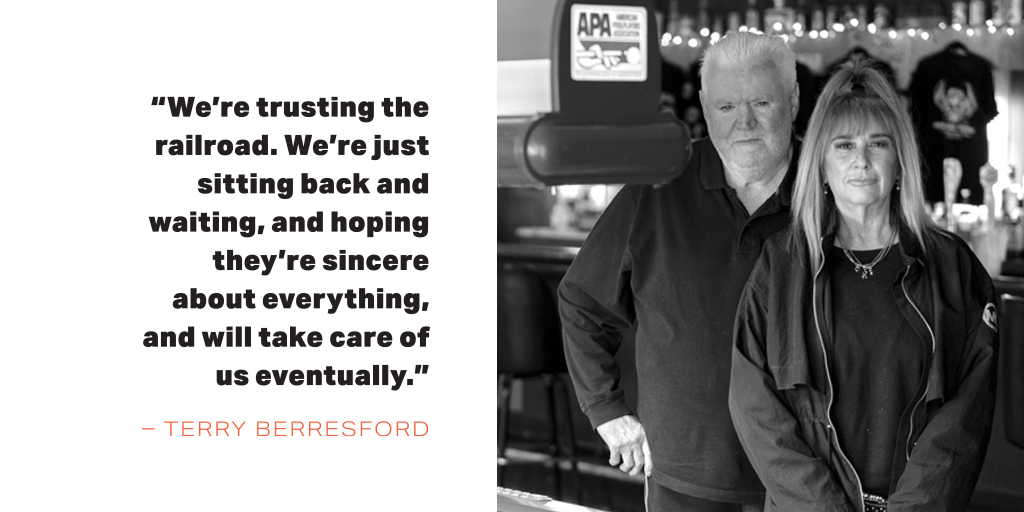
The Impact
Since those initial days of the derailment’s spills and smoke, EPA tests say the air is safe to breathe and the tap water is safe to drink. Any form of long-term adverse health effects, including cancer and autoimmune issues, are yet to be seen.
But there’s more to the derailment than spills and smoke. Public perception creates a host of concerns for East Palestine businesses’ revival.
In the months after the derailment, some consumers avoided food products from the East Palestine area. In late February, Giant Eagle removed water sourced from a plant located 25 miles away from the village, despite tests revealing no issues with the product.
Jeremy Haffey, co-owner of Haffey Family Farm, has seen negative perceptions of the area, but still gets support for his family’s business. The farm grows much of its produce on land in Enon Valley, Pennsylvania, two miles from the derailment. Haffey, his wife, Kim, and their three children grow and sell a wide range of fruits and vegetables at farmers markets and through CSA programs.
When the derailment occurred — and especially during the controlled release — Haffey Family Farm managed to avoid most of the smoke when wind pushed the cloud south.
Weeks later, the Haffeys tested their soil. The results showed the land was clean.
“We can confidently say that, with our products, they’re free of the toxins that you might find closer to the cities,” Jeremy says, “honestly, from steel mills and the pollution from them.”
Together, the family plants seeds in early March: asparagus, cabbage, kale. A few weeks later, onions and potatoes; then, transplants of small lettuce and strawberry plants; winding zucchini and yellow squash; corn and green beans. All these tiny green stems planted into a five-acre plot of land that only grows more lush, more green, as the season warms up.
That wintertime scare, feeling so long ago now, lingers for some customers. It doesn’t deter the Haffeys.
“We’ve seen a little bit of impact on the business but not a huge amount,” Jeremy says. “It still has given a little bit of fear to those who were closer. In the general area where the train derailed, people just are concerned.”
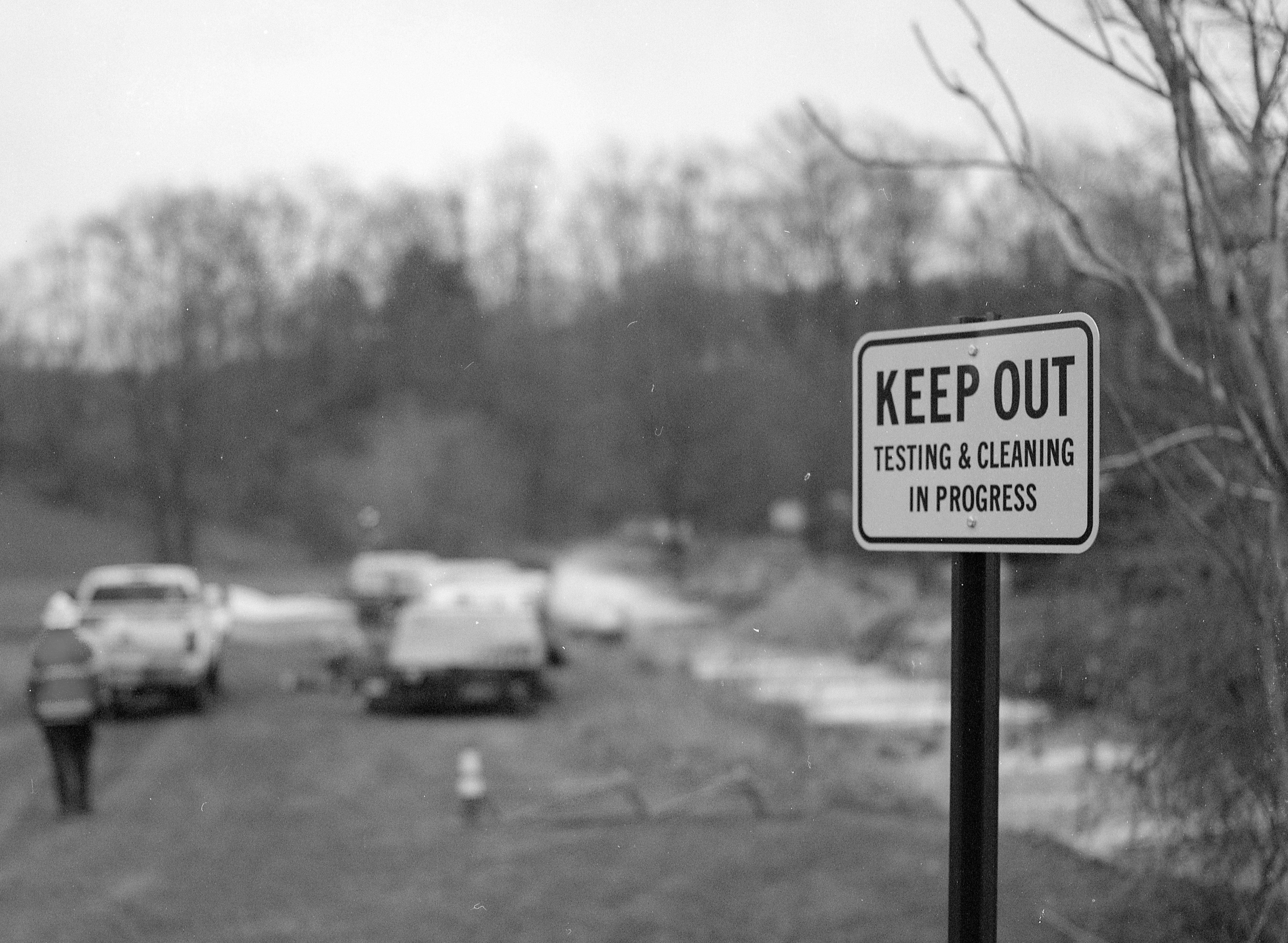
At Tall Pines Farms, a grass-fed beef and lamb farm in Darlington Township, Rachel Wagoner is still waiting to see the effect the derailment will have on her business. The farm, which has been in her husband’s family for four generations, seemed unaffected that February weekend, at least.
“Animals, while they don’t have complex and nuanced emotions like humans do, they do have emotions and do experience stress,” Wagoner says. “I kept an eye on everyone and everyone seemed totally fine, which I think is a pretty good indication we were OK, at least from acute impacts … but it’s been weird to be a person saying, ‘I don’t know, everything seems okay to me.’”
The business, mainly focused on direct-to-consumer sales, has only 10 cows to sell this year. Wagoner says she’s already sold some of the cows and hasn’t seen reluctance from former customers.
“I’m on the cusp of maybe finding out if there is some hesitancy to buy our beef,” Wagoner says. “While I haven’t had losses yet, I haven’t sold any beef from this year yet. I might know at the end of the year whether my business is down overall, and whether I can attribute it to this train derailment.”
Some businesses receive boosts of support but still worry about attitudes toward East Palestine. 1820 Candle Co. got an influx of orders when Cleveland author and columnist Connie Schultz shared a post about them on Facebook.
Still, manager Sidney Smith worries people won’t visit the store — a sleek, modern space where Lulu the pug regularly stands watch in the front window. Shelves of neatly arranged candles give off a variety of scents, including the Rust Belt Line featuring fragrances inspired by states in the region.
The shop smells warm and clean. Nothing like the chemical-laden smoke which plagued the village in February.
“You don’t even see the derailment on the main drag of town. To me, it’s freewill: If you’re scared, I don’t blame it, you can stay out,” Smith says, in late March. “If you want to come into town but you’re unsure, this is just somebody local saying it: I think it’s OK. We’re not growing new arms and eyes and legs.”
Smith and her fiance, busy planning their wedding for next year, look to buy a house, building their future in East Palestine.
“Personally, we feel comfortable being here,” Smith says. “I think we’re just going to continue toward doing that, and definitely keep an eye out and be cautious, definitely know what kinds of things are going on but, I guess, hope for the best and keep optimistic that everything’s gonna go well.”
East Palestine’s schools are still grappling with the derailment. After canceling classes for a week, extracurriculars faced challenges getting back on track for the remaining semester. Some competing sports teams refused to travel to East Palestine for games. Drama students picked up their rehearsals and squeezed in a long-overdue performance of The Lion King Jr.
Teachers, many of whom live in the village, instructed classes of in-person, displaced and remote students.
Gregg Brown is a psychiatric case manager at PsyCare who works at East Palestine schools. He and his family live in East Liverpool, about 11 miles away from the village, but he sends his kids to the school district, lauding its special needs programs — a good fit for his two children who are on the autism spectrum.
Overall, following the derailment, Brown sees the challenges faced not only by students but also the teachers expected to run classes every day following the February turbulence.
“I feel that the teaching staff needs to get more flowers than what they’re getting,” says Brown. “Like, 30% of the staff lives locally, that are dealing with this every day personally, whether it’s protecting their children, protecting themselves, their own valuables, their home, and then going and working and trying to make sure that they maintain their professionalism and maintain the safety of their students.”
In the months following the derailment, as schools let out for the summer, as media slows down its 24/7 coverage of the village, as crews clean up the chemicals in creeks, as Norfolk Southern doles out funds, as businesses get back on track and as legislation creeps forward, many East Palestine residents look toward an eventual return to normal.
Allison and her family, who moved from Cleveland to East Palestine (her husband Aaron’s hometown), long for the easygoing, quiet small-town feel they achieved when they landed here in 2019, just before the pandemic.
The kind of place with tight-knit churches, a cute downtown and plenty of woods and creeks for little ones to adventure in. The kind of place where kids pedal their bikes down slow neighborhood streets as the lights come on at night.
“We don’t want to have adverse health effects, years down the road, because we chose to stay here,” Allison says.
“We chose to move here because we wanted to raise our children in small town America,” she continues. “We just love being in East Palestine, and our goal is to be in East Palestine for the rest of our lives. Now with this train derailment, we still want to do that — but only if it’s safe.”
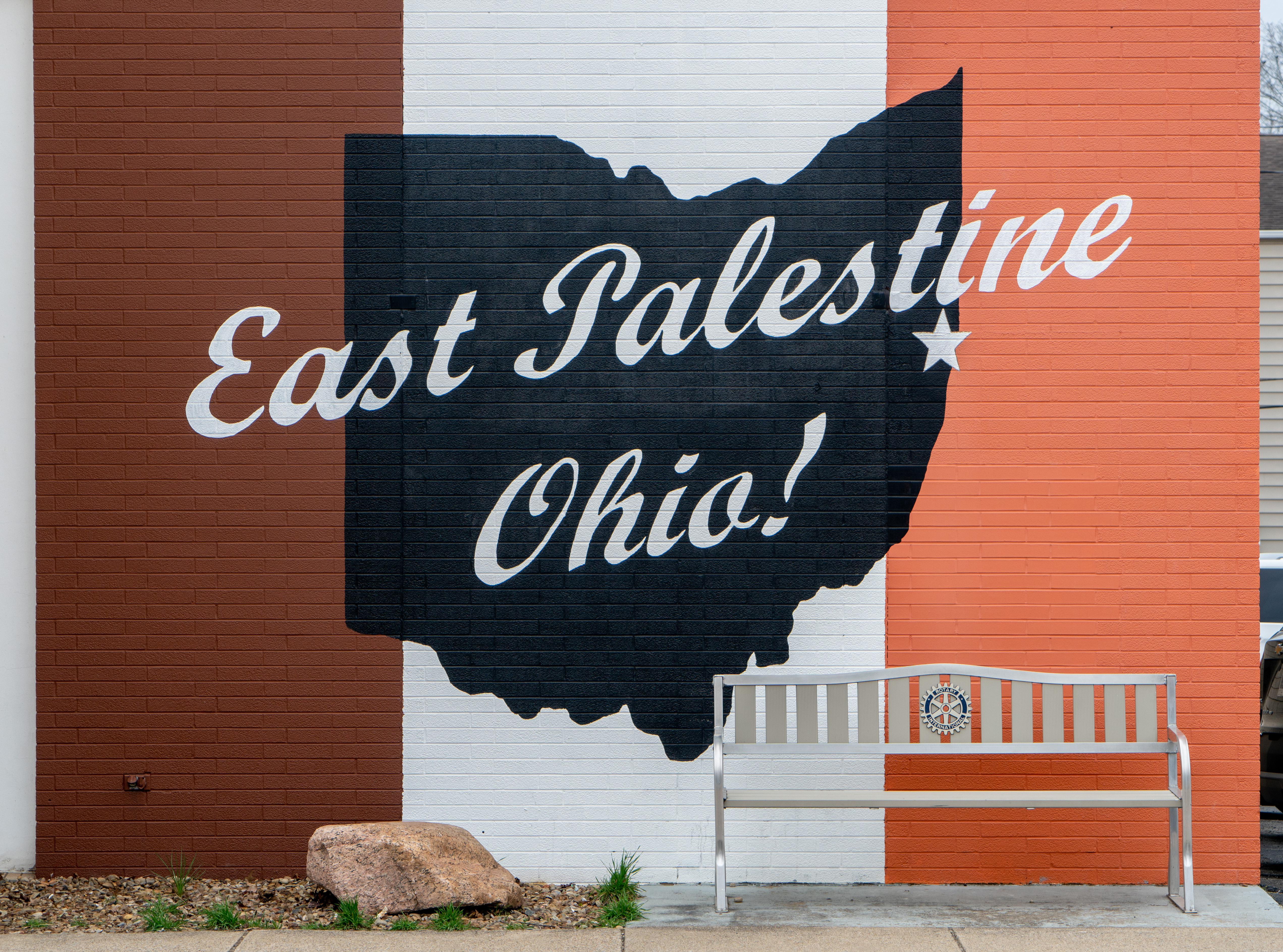
The Hope
The State Line Tavern lingers behind a “Road Closed” sign and a security checkpoint nearly two months after the crash.
Rumors initially floated around town that the business was destroyed, burned down in the wreckage, Terry says — and townspeople haven’t been able to get close enough to see for themselves that the small tavern still stands, much like it did before the derailment.
On the back wall, faded photos and funeral programs of longtime patrons are taped to the wood paneling. A few T-shirts are for sale, too, with a flaming motorcycle paired with the restaurant’s name on the back, and a simple phrase on the front: “F--- around and find out.”
When the Berresfords come in, occasionally they struggle to find a place to park next to the tankers and trucks that swarm their bar’s parking lot during the cleanup effort.
Standing on the back patio’s raised platform on an overcast day, they silently watch workers in orange vests shape and monitor the mounds of contaminated soil in the tavern’s backyard, covered by plastic tarps.
Frowning, they walk back inside.
While some dumps have turned away this contaminated soil, much of it has been taken in Michigan and Ohio and burned in incinerators.
It’s been a slow process.
They say they haven’t heard anything from Norfolk Southern about compensation. They say they plan to host a big party when they reopen the bar, inviting all of the orange-vested workers who have been busy in their backyard for months. They say they’ve been told they may be able to reopen the bar, that this cleanup should be done, by September or October.
The date has been pushed back multiple times.
Out back, this hill of soil, moved from the derailment site 500 yards down the tracks, has piled up and down, trucked out of the Berresfords' property, since February. The process is ongoing in June — trucks, still, lifting and moving the contaminants.
Still cleaning up.
Here is where the smell hits you. It sneaks into what should smell like asphalt and a grassy field and stale beer. Instead, the smell of chemicals, of plastic, unplaceable and bad. Standing on the bar’s back patio, the corners of a headache fold in, months after the derailment.
Leaving the bar, the smell dissipates. It’s left behind, but not completely gone. This one lingering reminder of the nightmare in East Palestine.

Annie Nickoloff
Annie Nickoloff is the senior editor of Cleveland Magazine. She has written for a variety of publications, including The Plain Dealer, Alternative Press Magazine, Belt Magazine, USA Today and Paste Magazine. She hosts a weekly indie radio show called Sunny Day on WRUW FM 91.1 Cleveland and enjoys frequenting Cleveland's music venues, hiking trails and pinball arcades.
Trending
-
1
-
2
-
3
-
4
-
5


